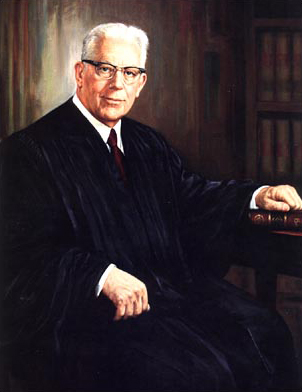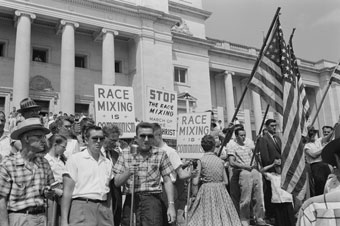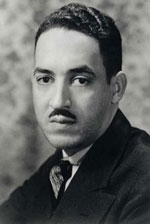Brown v. Board of Education
May 17, 1954: The 'separate is inherently unequal' ruling forces Eisenhower to address civil rights
Segregation of white and colored children in public schools has a detrimental effect upon the colored children. . . . We conclude that in the field of public education the doctrine of ‘separate but equal’ has no place. Separate educational facilities are inherently unequal.
In 1954, Chief Justice Earl Warren wrote this opinion in the unanimous Supreme Court decision Brown v. Board of Education of Topeka. Citing a violation of the Fourteenth Amendment’s Equal Protection Clause, the groundbreaking decision was widely regarded as one of America's most consequential legal judgments of the 20th century, setting the stage for a strong and lasting US Civil Rights Movement. Thurgood Marshall, lead counsel on the case, would go on to become a Supreme Court Justice himself.

The Brown decision reverberated for decades. Determined resistance by whites in the South thwarted the goal of school integration for years. Even though the court ruled that states should move with “all deliberate speed,” that standard was simply too vague for real action. Neither segregationists, who opposed to integration on racist grounds, nor the constitutional scholars who believed the court had overreached were going away without a fight.
President Eisenhower didn't fully support of the Brown decision. The president didn't like dealing with racial issues and failed to speak out in favor of the court's ruling. Although the president usually avoided comment on court decisions, his silence in this case may have encouraged resistance. In many parts of the South, white citizens' councils organized to prevent compliance. Some of these groups relied on political action; others used intimidation and violence.

Despite his reticence, Eisenhower did acknowledge his constitutional responsibility to uphold the Supreme Court’s rulings. In 1957, when mobs prevented the desegregation of Central High School in Little Rock, Arkansas, Governor Orval Faubus saw political advantages in using the National Guard to block the entry of African American students to Central High. After meeting with Eisenhower, Faubus promised to allow the students to enroll—but then withdrew the National Guard, allowing a violent mob to surround the school. In response, Eisenhower dispatched federal troops, the first time since Reconstruction that a president had sent military forces into the South to enforce federal law.
In explaining his action, however, Eisenhower did not declare that desegregating public schools was the right thing to do. Instead, in a nationally televised address, he asserted that the violence in Little Rock was harming US prestige and influence around the world and giving Communist propagandists an opportunity “to misrepresent our whole nation.” Troops stayed in Little Rock for the entire school year, and in the spring of 1958, Central High had its first African American graduate.
But in September 1958, Faubus closed public schools to prevent their integration. Eisenhower expressed his “regret” over the challenge to the right of all Americans to a public education but took no further action, despite what he had done the year before. There was no violence this time, and Eisenhower believed that he had a constitutional obligation to preserve public order, not to speed school desegregation. When Eisenhower left the White House in January 1961, only 6 percent of African American students attended integrated schools.
Eisenhower and integration
Eisenhower urged advocates of desegregation to go slowly. believing that integration required a change in people's hearts and minds. And he was sympathetic to white southerners who complained about alterations to the social order—their “way of life.” He considered as extremists both those who tried to obstruct decisions of federal courts and those who demanded that they immediately enjoy the rights that the Constitution and the courts provided them.
On only one occasion during his presidency—in June 1958—did Eisenhower meet with African American leaders. The president became irritated when he heard appeals for more aggressive federal action to advance civil rights and failed to heed Martin Luther King Jr.’s advice that he use the bully pulpit of the presidency to build popular support for racial integration. While Eisenhower’s actions mattered, so too did his failure to use his moral authority as president to advance the cause of civil rights.
Eisenhower's record, however, included some significant achievements in civil rights. In 1957, he signed the first civil rights legislation since Reconstruction, providing new federal protections for voting rights. In most southern states, the great majority of African Americans simply could not vote because of literacy tests, poll taxes, and other obstacles. Yet the legislation Eisenhower eventually signed was weaker than the bill that he had sent to Capitol Hill. Southern Democrats secured an amendment that required a jury trial to determine whether a citizen had been denied his or her right to vote—and African Americans could not serve on juries in the south. In 1960, Eisenhower signed a second civil rights law, but it offered only small improvements. The president also used his constitutional powers, where he believed that they were clear and specific, to advance desegregation, for example, in federal facilities in the nation's capital and to complete the desegregation of the armed forces begun during Truman’s presidency. In addition, Eisenhower appointed judges to federal courts whose rulings helped to advance civil rights. This issue, which divided the country in the 1950s, became even more difficult in the 1960s.
